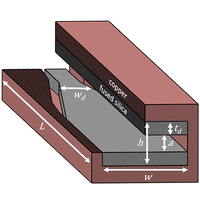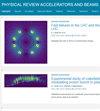Terahertz-driven acceleration of subrelativistic electron beams using tapered rectangular dielectric-lined waveguides
IF 1.5
3区 物理与天体物理
Q3 PHYSICS, NUCLEAR
Physical Review Accelerators and Beams
Pub Date : 2024-04-11
DOI:10.1103/physrevaccelbeams.27.041302
引用次数: 0
Abstract
We investigate the use of tapered rectangular dielectric-lined waveguides (DLWs) for the acceleration of low-energy, subrelativistic, electron bunches by the interaction with multicycle narrowband terahertz (THz) pulses. A key challenge exists in this subrelativistic regime; the electron velocity changes significantly as energy is gained. To keep electrons in the accelerating phase, the phase velocity must also be increased to match. We present simulations which demonstrate that the dielectric thickness can be kept constant and the width of the dielectric lining can be tapered along the direction of travel to vary the phase velocity, an approach only possible by the use of a rectangular waveguide geometry. The properties of tapered DLWs are discussed and following this, a design process is presented to demonstrate that the way this tapering can be optimized for different pulse and beam parameters. The minimum accelerating gradient for electron bunch capture is derived and compared to simulations. As examples of this design process, designs are considered based on considerations of the THz source, incoming electron beam, and manufacturing tolerances. A maximum THz pulse energy of in the DLW was considered, which represents what is readily achievable using mJ-level regenerative amplifier laser systems together with optical-to-terahertz conversion in lithium niobate crystals. This will be more than double the energy of a 100 keV electron beam, increasing it to 205 keV. We describe the optimization process and present a detailed exploration of the beam dynamics, discussing how the performance will further improve with compressed bunches.

利用锥形矩形介质衬里波导实现次相对论电子束的太赫兹驱动加速
我们研究了如何利用锥形矩形介质衬里波导(DLW),通过与多周期窄带太赫兹(THz)脉冲的相互作用,加速低能量、亚相对论电子束。亚相对论机制存在一个关键挑战:随着能量的增加,电子速度会发生显著变化。要使电子保持在加速阶段,还必须提高相位速度以与之相匹配。我们的模拟结果表明,电介质厚度可以保持不变,而电介质衬里的宽度可以沿行进方向逐渐变细,从而改变相位速度,这种方法只有通过使用矩形波导几何形状才能实现。本文讨论了锥形 DLW 的特性,随后介绍了一个设计过程,以演示如何根据不同的脉冲和光束参数优化锥形 DLW。得出了电子束捕获的最小加速梯度,并与模拟结果进行了比较。作为设计过程的示例,我们考虑了基于太赫兹源、输入电子束和制造公差的设计。在 DLW 中考虑的最大太赫兹脉冲能量为 22.5 μJ,这代表了利用 mJ 级再生放大器激光系统以及铌酸锂晶体中的光-太赫兹转换可以轻易实现的能量。这将是 100 千伏电子束能量的两倍多,将其提高到 205 千伏。我们介绍了优化过程,并对电子束动力学进行了详细探讨,讨论了如何通过压缩束来进一步提高性能。
本文章由计算机程序翻译,如有差异,请以英文原文为准。
求助全文
约1分钟内获得全文
求助全文
来源期刊

Physical Review Accelerators and Beams
Physics and Astronomy-Surfaces and Interfaces
CiteScore
3.90
自引率
23.50%
发文量
158
审稿时长
23 weeks
期刊介绍:
Physical Review Special Topics - Accelerators and Beams (PRST-AB) is a peer-reviewed, purely electronic journal, distributed without charge to readers and funded by sponsors from national and international laboratories and other partners. The articles are published by the American Physical Society under the terms of the Creative Commons Attribution 3.0 License.
It covers the full range of accelerator science and technology; subsystem and component technologies; beam dynamics; accelerator applications; and design, operation, and improvement of accelerators used in science and industry. This includes accelerators for high-energy and nuclear physics, synchrotron-radiation production, spallation neutron sources, medical therapy, and intense-beam applications.
 求助内容:
求助内容: 应助结果提醒方式:
应助结果提醒方式:


